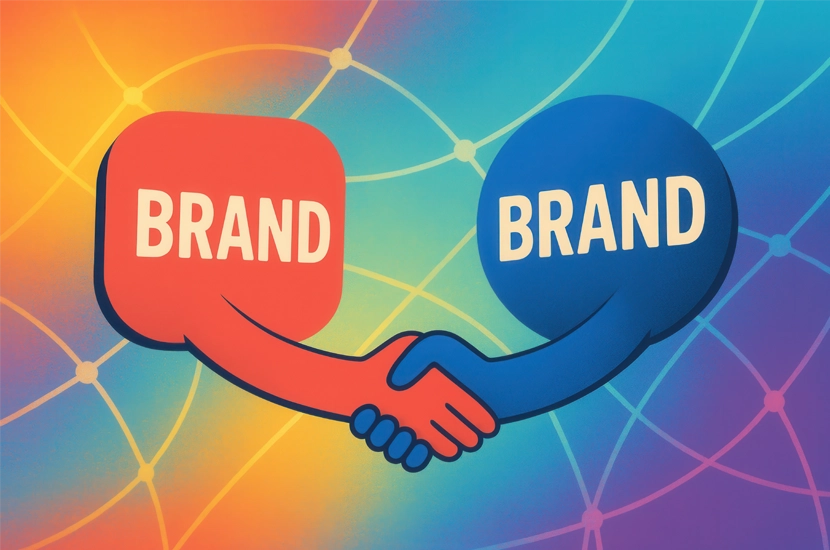Brand-to-brand has become a strategic affiliation lever for advertisers and supporting brands. This model involves setting up cross-brand partnerships to generate relevant, measurable and value-creating interactions.
Multiple targeted activations
Brand-to-brand campaigns take the form of a wide variety of activations on proprietary channels, often under-exploited by brands:
- CRM databases and newsletters: highlighting partners in e-mailing communications to already-qualified audiences.
- Transaction paths: integration of offers on the shopping cart page, the order confirmation page or in post-purchase e-mail receipts.
- Physical supports: parcel inserts, packaging enriched with partner offers, discount cards.
- Strategic digital spaces: home pages, category pages, premium zones on e-commerce sites or online customer areas.
By drawing on qualified audiences already committed to the supporting brand, these activations guarantee a high level of relevance and boost campaign performance.
Benefits shared by all parties
For the advertiser
- Access to new points of contact with captive, qualified audiences.
- Increased brand awareness in a trusted environment.
- Opportunity to reach prospects who are in the process of buying or close to doing so, thus increasing the conversion rate.
For the support brand
- Monetize its proprietary spaces.
- Enhance customer relations with useful, complementary offers.
- Generate additional recurring revenues, often with a higher ROI than traditional channels.
For the consumer
- Discover relevant, contextualized offers.
- An enriched, non-intrusive experience that adds value.
- Access to exclusive benefits at the most opportune moment in your career.
Brand-to-brand growth drivers
The rapid development of brand-to-brand affiliation is explained by two main dynamics:
Professionalizing technological solutions
Specialized solutions (Sovendus, Rokt, Rakuten Advertising, Getinside, etc.) now make it easier to connect brands. They provide reliable tracking, detailed reporting and optimized product flow management.
The search for alternative acquisition channels
At a time when traditional media costs (SEA, social ads, programmatic display) are skyrocketing, advertisers are looking to diversify their marketing mix. Brand-to-brand meets this need by offering a sustainable, measurable and high-performance lever.
In this way, brand-to-brand is no longer limited to one-off operations, but tends to be integrated as a strategic lever, in the same way as affiliation’s historical partners: cashback, content sites, promo codes or comparators.
Post-purchase: a key moment to exploit
The post-purchase phase is a particularly suitable territory for activating brand-to-brand campaigns.
- The order confirmation page, long perceived as purely transactional, is becoming a strategic media space. Users are attentive, satisfied with their purchase and receptive to offers.
- Order confirmation or follow-up e-mails are also premium media for partner offers.
Concrete examples
- Sovendus and its Voucher Network: after a purchase, the customer receives a discount offer from a partner. The supporting brand monetizes its confirmation page, the advertising brand gains visibility, and the consumer benefits from an immediate advantage.
- Rokt: using algorithmic personalization technology, Rokt inserts internal (upsell) or external (partner) offers into the user experience in real time. The result: significant additional revenues and an enriched shopping experience.
Marketplaces and product flow integration
Some support brands go even further, directly integrating advertisers’ product feeds. Rakuten France, for example, lets merchants import their catalogs to make them visible to its transactional audience.
- Advantage for the advertiser: continuous, qualified exposure to millions of users.
- The benefits for the marketplace: an enriched catalog and improved customer experience thanks to greater choice.
Premium private sales areas
Private sales platforms (Showroomprivé, The Bradery, Veepee, etc.) offer highly strategic advertising space:
- Home page and category pages.
- Newsletters and push notifications.
- Dedicated areas for special events or flash sales.
These premium activations generate additional sales with highly engaged audiences in a world of affinity and theme-based purchasing.
Parcel inserts: a highly memorable physical medium
The parcel, the last point of physical contact between a brand and its customer, becomes a media medium. With solutions like Getinside, advertisers can slip a partner offer directly into the parcel.
- Benefits for the advertiser: reach a customer in a post-purchase situation via a tangible medium that encourages recall.
- Benefits for the supporting brand: enrich the customer experience and enhance the value of the shipment with useful content.
Customer areas: sustainable digital leverage
Often under-exploited, customer spaces represent a major brand-to-brand opportunity.
Subscribed or registered users regularly consult their personal space (account, dashboard, loyalty program).
Brands can insert discreet, relevant partner offers without disrupting the user experience.
Advantages :
- propose relevant offers in a familiar environment,
- target an engaged and receptive audience,
- and increase the perceived value of a subscription or service.
Brand-to-brand, a future pillar of performance marketing
Affiliate brand-to-brand illustrates the transformation of performance marketing:
- More integrated into the customer journey.
- More respectful of audiences thanks to contextualized offers.
- More diversified channels and contact points.
By transforming every proprietary asset into a media opportunity, brands are opening up new avenues for growth.
Advertisers find a new source of qualified acquisition, supporting brands monetize their space, and consumers benefit from useful, contextualized offers.
As solutions become more professional and pressure on media budgets intensifies, affiliate brand-to-brand is set to become an essential lever, complementing traditional affiliate players.




